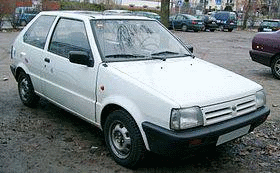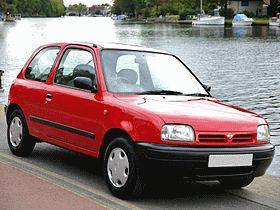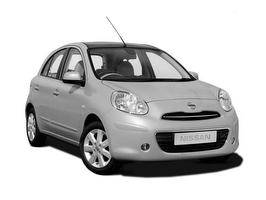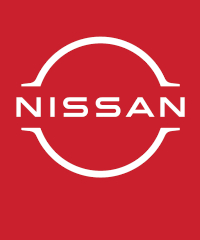Celebrating 30 years of the Nissan Micra!
Spanning over 3 generations – October 1982 – present!
From 1992 Micras were built in the UK at the NMUK plant in Sunderland, Tyne and Wear, where a total of 2,368,704 were built at its close in July 2010.

FIRST GENERATION 1982 – 1992
K10 October 1982 – 21 December 1992
The Micra K10 first went on sale the UK over the summer of 1983 as a challenge to the highly successful Honda City. It was intended to replace the Nissan Cherry as the company’s competitor in the Super-mini Sector.
Although Nissan was slowly phasing out the Datsun name, a small “Datsun” appeared on the tailgate for the first 2 years and was known in some European Countries as “Datsun-Nissan Micra”. By the end of 1984 the Datsun badge had completely disappeared.
The Nissan Micra was first modified in June 1985 with the slightly larger rear clusters. This was the start of many facelifts and adaptions. In 1989 further modifications were made with deeper bumpers, new front grille, minor interior details and headlight changes and also a 5dr hatchback version.
The Nissan Micra was an instant sales success. In its best year, 1990, it was the eleventh most popular new car in the UK with just under 50,000 sales. It was a popular choice with driving instructors and undemanding motorists thanks to its ease of driving, solid build and durable mechanical components. 343,411 were sold in nearly a decade. As recently as early 2007, almost 15 years after the last examples were sold, 96,421 examples were still reported to be in circulation, and four years on, as the 20th anniversary of its demise approaches, the number remaining on Britain’s roads is likely to be still well into five figures. It compares particularly well to many other popular small cars in Britain of its era, particularly the British-built Austin Metro and Italian Fiat Uno.
 SECOND GENERATION 1992 – 2003
SECOND GENERATION 1992 – 2003
K11 1992 – 1997
The second incarnation of the Micra, the K11, was launched in the UK at the end of 1992, with production taking place in Britain at the Sunderland plant rather than in Japan. It was available with a limited range of engines: 1.0 and 1.3 petrol units. Power steering was an option on some models, however in 1998 6 years after the launch of the Nissan Micra power steering was available as a standard option.
In 1993 the Nissan Micra won the European Car of the Year and Car of the Year Japan.
In late 1997 saw the introduction of the S and SE models,(also known as K11 C facelift) these were built up until early 2003, the facelift included a revised front grille and headlights, redesigned front and rear bumpers, and much more.
In 1998, the Sunderland plant produced its millionth Micra, becoming the first Japanese manufacturer in Europe to achieve the milestone.
The modifications continued in 2000 when the original facelift was updated with a second version. Changes included new lights on the bumper, lower body, orange turn signals and a complete new interior. A facelift over the summer of 2000 saw the 1.3 shelved and replaced with a 1.4 unit. This upgrade, after a previous makeover in 1998, enhanced the Micra’s appeal and it was still fairly popular on the launch of its successor in December 2002.
The Micra K11 (as it is known in Europe), was the second model after the Primera built in Nissan’s NMUK plant in Sunderland, Tyne and Wear.
THIRD GENERATION 2002 – 2010
K12 2002 – 2010
Like the previous version of the Micra, the third generation model, the K12, was made at the Sunderland plant. The radical redesign featured a 70mm longer wheelbase and a taller slightly wider curvy exterior. The most noticeable change was the prominent headlamps that extended to the wing tops. There was also an induction of the sliding rear seat and keyless ignition ( on higher specs).
It had a wider range of engines, including 1.2 petrol and Renault sourced 1.5 direct-injection diesel power-plants, the automatic CVT transmission had been replaced by the conventional automatic transmission. This stylish, all-new Micra helped Nissan bolster its market share of the super-mini sector, which had been declining in the final year or two of its predecessor’s life.
In 2003, the BBC.s Top Gear program features a segment on cars that gave value for money, highlighting specification that could be purchased for £9000. The Micra K12 was selected and tested by presenter Richard Hammond, who gave it a positive review. This was despite comparing its qualities to those of a Boeing 737, concluding the Micra “had all the toys”
In July 2004, Nissan announced that a Coral Blue K12 Micra had become NMUK’s one millionth car for the UK market, and that its Sunderland plant had produced over 250,000 K12s since the model’s launch, for sale up to 45 markets.
 MICRA C+C (2005 – )
MICRA C+C (2005 – )
June 2005 saw the launch of the Nissan Micra C+C. This was designed at the London based design studio and built at the Sunderland plant. it was a modern interpretation of the Nissan Figaro but with the added luxury of a folding glass roof, This was available in a 1.4 and 1.6 Petrol and 1.5DCI Engine. There were originally four trim levels, Urbis, Sport, Essenza and Active Luxury.
The pink C+C was one of only five, made specifically for Nissan’s sponsorship of the C+C TLC Tour in 2005–06, in support of the Breakthrough Breast Cancer charity. Such was the public’s response that Nissan subsequently announced the launch of the Micra C+C Pink, limited to 100 models. These quickly sold out and another production run was announced in August 2006, this time limited to 175 cars.
In August 2006, the K10 was still receiving credit for its impressive durability. An Auto Express survey revealed that of the 340,000 K10 Micras registered in the UK between 1983 and 1992, 96,000 were still on the road—nearly 30%, an impressive figure for a car which had been out of production for 14 years. This gave it a far higher rating than the Fiat Uno and the Austin Metro, both of which had dwindled away to less than 3%.
In 2007, with the Micra K12C, the model grades were brought into line with the rest of the Nissan UK range, namely Visia, Acenta, Tekna, 160 SR and Active Luxury.
The Micra C+C convertible was available in Visia, Acenta, Tekna and Active Luxury grades. However, the 1.6-litre engine is available for all models, save the Visia.
 FOURTH GENERATION 2010 – present day
FOURTH GENERATION 2010 – present day
Micra K13 – 2010 –
The first sketches of the latest edition of the Nissan Micra were unveiled on 1st October 2009. It was to be sold in 160 countries and would be based on the new Type V Platform with a new 1.2 litre 3 cylinder engine. The latest ESP system includes ABS, 6 Airbags and 5 head restraints as standard on all models.
At the end of 2011 the Supercharged version the Micra 1.2 Dig S was introduced. The new idling stop start system is reported to improve fuel economy by 2.0km/l. A lightweight roof panel helps to keep its weight to 915kg.
This car was designed to appeal to a unisex crowd, but at the same time look stylish and elegant against tough competition.
POLESWORTH GARAGE HAVE A RANGE OF THE EVER POPULAR NISSAN MICRA READY TO VIEW AND TEST DRIVE. SO WHY NOT VISIT OUR SHOWROOM AND SEE THE NISSAN THAT HAS BEEN GROWING IN SUCCESS FOR 30 YEARS.
TO BOOK A TEST DRIVE IN THE NEW NISSAN MICRA, SIMPLY VISIT OUR SHOWROOM OR CALL US ON 01827 895125 OR EMAIL enquiries@polesworth-garage.com
NEW YEAR, NEW OFFERS AVAILABLE!!!
 Polesworth Garage
Polesworth Garage



